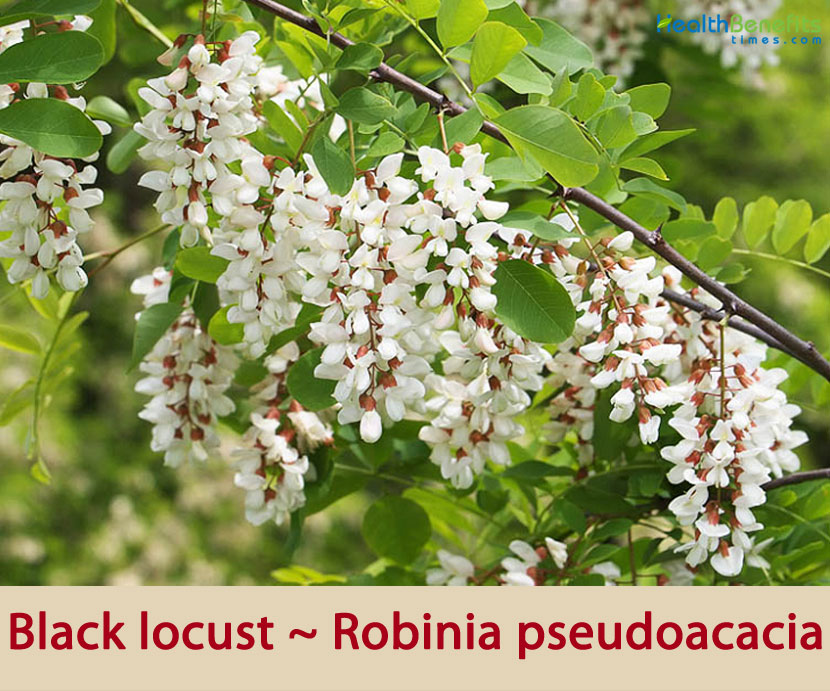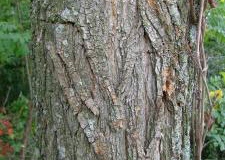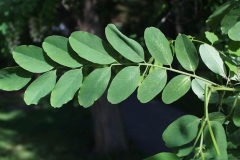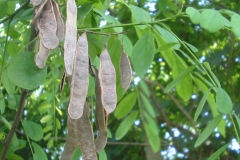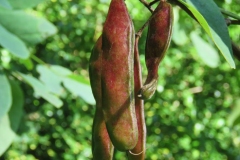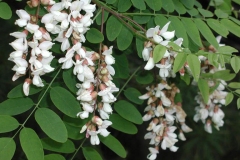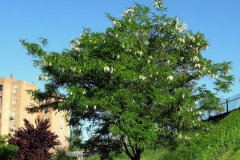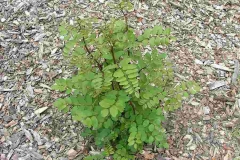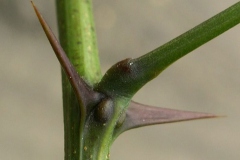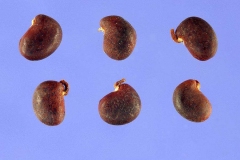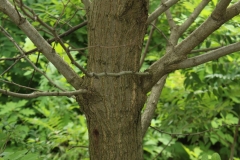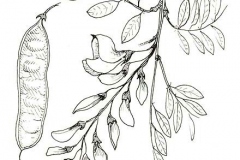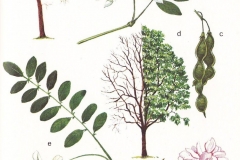| Black Locust Quick Facts | |
|---|---|
| Name: | Black Locust |
| Scientific Name: | Robinia pseudoacacia |
| Origin | Eastern United States |
| Colors | Green turning to brown in color as it matures |
| Shapes | Small, elongated and flattened pea-like pod that are 3-8 cm long and 10-15 mm wide |
| Taste | Sweet |
| Health benefits | Beneficial for asthma, bronchitis, hyperacid gastritis, distensions, headaches, stress, insomnia, toothache, fevers, migraine and eye ailments |
| Name | Black locust |
|---|---|
| Scientific Name | Robinia pseudoacacia |
| Native | Few small areas of the Eastern United States, but it has been widely planted and naturalized elsewhere in temperate North America, Europe, Southern Africa, Australia, New Zealand, Asia, other parts of North America and is considered an invasive species in some areas |
| Common Names | Black locust tree, Chinese scholar tree, common robinia, false acacia, locust tree, robinia, ship-mast locust, yellow locust, post locust, white acacia, acacia locust, honey locust, white locust, locust |
| Name in Other Languages | Afrikaans: Swart sprinkaan, witakasia, Vals akasia Albanian: Karkalec i zi, robinie Amharic: Tik’uri ānibet’a (ጥቁር አንበጣ) Arabic: Aljirad al aswad (الجراد الأسود), rubinia (روبينيا), rubiniat sintia (روبينية سنطية) Armenian: Sev morekh (սև մորեխ), Spitak Kakia, spitak akats’ia (սպիտակ ակացիա) Azerbaijani: Qara çəyirtkə, Ay Akasia, Ağ akasiya Basque: Sasiarkasia Belarusian: Belaya akatsiya (Белая акацыя) Bengali: Kālō paṅgapāla (কালো পঙ্গপাল) Bosnian: Bagrem Brazil: Acacia-salsa Bulgarian: Cheren skakalets (черен скакалец), akatsiya byala (акация бяла), bil salkŭm (бил салкъм), byala akatsiya (бяла акация), salkŭm (салкъм) Burmese: Kyaine kaung (ကျိုင်းကောင်) Catalan: Acàcia falsa, falsa acacia, robínia, Acàcia borda Chinese: Cìhuái (刺槐), Yang huai, Chinese scolartree Croatian: Crna skakavac, bagrem, mirisavi bagrem, Agacija Czech: Cerný kobylka, Agát biely, akát, trnovník akát, trnovník bílý Danish: Sort græshoppe , Almindelig robinie, Robinie, Uægte Akacie Dutch: Zwarte sprinkhaan, Gewone robinia, Robinia, schotdoorn, Pseudoacacia, Valse acacia, Witte acacia English: Black locust, False Acacia, Locust tree, Chinese scholar tree, acacia locust, honey locust, robinia, white acacia, white locust, yellow locust, locust Esperanto: Nigra akrideto, Blanka robinio, Ŝajnakacia robinio Estonian: Must jaanileib, harilik robiinia Filipino: Itim na baling Finnish: Musta johanneksenleipä, Valeakaasia, Valkovaleakaasia French: Criquet noir, Acacia Blanc, Robinier, Robinier Faux-acacia, Robinier faux acacia, acacia des jardiniers, Acacia, acacia du pays, carouge, cassie Galician: Acacia bastarda, Falsa acacia Georgian: Shavi k’alia (შავი კალია), Eklis Khe German: Robinie, Falsche Akazie, Gewöhnliche Robinie, Gewöhnliche Scheinakazie, Scheinakazie, Schoterndorn, Akazie, gemeine Robinie, Silberregen, weiße Robinie, Gemeiner Schotendorn Greek: Mávri akrída (μαύρη ακρίδα), Psevdakakia (ψευδοακακία), Rovinia (Ροβινία ), Rovínia i psevdoakakía (Ροβίνια η ψευδοακακία), Akakía (Ακακία) Gujarati: Kāḷī tīḍa (કાળી તીડ) Hausa: Baƙar fata Hebrew: ארבה שחורה, Robinia bat-ha’shita, רוביניה בת-השיטה Hindi: Kaale tiddee (काले टिड्डी), kikar, robinia kikar Hungarian: Fekete sáska, Fehér akác, akactermesztes Icelandic: Svartur engisprettur Indonesian: Belalang hitam Irish: Locust dubh, Acaicia bréige Italian: Locusta near, Falsa Acacia, Robinia, acacia; cascia, acacia, acacia cascia, acacia falsa, gaggia, robinia, robinia pseudacacia, Maruga, Japanese: Inago (イナゴ), Nise akashia (ニセアカシア), Robinia (ロビニア), Harienju (ハリエンジュ) Javanese: Belalang ireng Kannada: Kappu miḍate (ಕಪ್ಪು ಮಿಡತೆ) Kazakh: Qara şegirtke (қара шегіртке) Korean: Geom-eun mettugi (검은 메뚜기), a ga si na mu, akasianamu (아가시나무) Kurdish: Koka reş Lao: Non sidoa (ໜອນ ສີດໍາ) Latin: Nigrum locusta Latvian: Melnais siseis, Balt, baltā robīnija Lithuanian: Juodasis skėris, Baltažiedė robinija Macedonian: Crn skakulec (црн скакулец), Багрем Malagasy: Valala mainty Malay: Belalang hitam Malayalam: Kaṟutta veṭṭukkiḷi (കറുത്ത വെട്ടുക്കിളി) Maltese: Ħarrub iswed, Robinja Marathi: Kāḷā ṭōḷa (काळा टोळ) Mongolian: Khar tsartsaa (Xар царцаа) Nepali: Kālō salaha (कालो सलह) Netherlands: Robinia, schotdoorn Norwegian: Svart gresshopp, Robinia, storrobinia, Black locust, Falsk akasie Occitan: Acacia, robinia, robinèr, Cacièr Oriya: କଳା ପଙ୍ଗପାଳ | Pakistan: Kikar, robinia kikar Pashto: تور ملخ Persian: ملخ سیاه, اقاقیای سیاه Polish: Czarna szarańcza, Grochodrzew Bialy, Robinia akacjowa, Robinia biały, grochodrzew akacjowy, Robinia biała, Robinia pseudacacia, Robinia pseudoakacja Portuguese: Gafanhoto preto, Acacia Bastarda, Acácia-da-terra, Acácia-de-flores-brancaas, Falsa-acácia, acácia-boule, acácia-pára-sol, robínia, acacia-salsa Punjabi: Kālē ṭiḍī (ਕਾਲੇ ਟਿੱਡੀ) Romanian: Lăcustă neagră, Salcam, Salkym Alb, salcîm Russian: Chernaya sarancha (черная саранча), Belaya Akatziya, Lzheakatziya, Robiniya Lozhno-akatziya, Robiniya Lzheakatziya, Akatsiia belaia (Акация белая), Belaia akatsiia (белая акация), Robiniia psevdoakatsiia (Робиния псевдоакация), robiniya lozhno-akatsiya (робиния ложно-акация), robiniya obyknovennaya (робиния обыкновенная), robiniya psevdoakatsiya (робиния псевдоакация), Lzheakatsiya (Лжеакация), Robiniya-lzheakatsiya (Робиния-лжеакация) Sardinian: Acacia Serbian: Skakavac (скакавац), Багрем Sinhala: Kaḷu paḷan̆gæṭiyan (කළු පළඟැටියන්) Slovak: Agát biely Slovenian: Crna kobilica, robinija Spanish: Algarrobo negro, Acacia Blanca, Acacia bastarda, Acacia de bola, Acàcia falsa, Aromo blanco, Falsa acacia, Mamachocho, Pan y quesillos, Robinia, Acacia de dos púas, Acacia de flor blanca, Acacia de los paseos, Falso aromo, acacia blanquera, acacia Espinosa, alcasia, arcazia, escasia, pan y quesito, pan y queso, robinia, Navadna robinija, Navadna robinja, Neprava akacija Sudanese: Belalang hideung Swedish: Svart gräshoppa, Robinia-akacia, Robinia, Falsk akasia, vanlig robinia Tajik: Malaxi sijoh (малахи сиёҳ), Aqoqijo (Ақоқиё) Tamil: Karuppu veṭṭukkiḷi (கருப்பு வெட்டுக்கிளி) Tatar: Ак сәрви агачы Telugu: Nalla miḍuta (నల్ల మిడుత) Thai: Tạ́ktæn s̄ī dả (ตั๊กแตนสีดำ) Turkish: Siyah Çekirge, yalancı akasya, Beyaz çiçekli yalancı akasya, Beyaz çiçekli yalancıakasya Ukrainian: Sarana (сарана), Bila Akatziya, robiniya zvychayna (робінія звичайна), Akatsiya bila (Акація біла), Bila akatsiya (Біла акація), Robiniya zvychayna (Робінія звичайна), Robiniya psevdoakatsiya (Робінія псевдоакація) Urdu: کالی ٹڈی Uzbek: Qora chigirtka Vietnamese: Châu chấu màu đen, Dương hòe Welsh: Locust du, coeg-acasia Zulu: Isikhonyane esimnyama |
| Plant Growth Habit | Medium-sized, fast-growing, hardwood deciduous root suckering tree |
| Growing Climates | Forests, riparian habitats, grassland, rocky places, waste places, scrubland, forest margins and clearings, woods and thickets, dry prairies, sand prairies, savannas, riverbanks, roadsides, disturbed sites, gardens, urban bush land, open woodlands in temperate and sub-tropical regions |
| Soil | Grow in a variety of soils, except that excessively dry or compact plastic soils are undesirable. Limestone soils are especially favorable, and soils without pronounced subsoil development are best |
| Plant Size | About 40–100 feet (12–30 m) with a diameter of 2–4 feet (0.61–1.22 m). Exceptionally, it may grow up to 52 meters (171 ft.) tall and 1.6 meters (5.2 ft.) diameter in very old trees |
| Root | Shallow and wide-spreading root system that is excellent for soil binding but is also capable of producing deep roots (5-7 m deep). Radial root spread is about 1 to 1.5 times tree height |
| Twigs | Zigzag, somewhat stout and angular, red-brown in color, numerous lighter lenticels. Paired spines at each leaf scar (often absent on older or slow growing twigs); buds are submerged beneath the leaf scar |
| Bark | Bark of young trees is brown or greenish, smooth and with conspicuous lenticels (pores) and spines. It becomes deeply tan or gray-brown and eventually becomes deeply furrowed with flat-topped ridges in older trees |
| Branches | Branches are typically zig-zaggy and may have ridges and grooves or may be round. |
| Wood | Pale yellowish brown, heavy, hard, strong, close-grained, and very durable in contact with the ground. The wood has a specific gravity of 0.7333, and a weight of approximately 732 kg per cubic metre (45.7 pounds per cubic foot) |
| Leaf | Alternately arranged leaves are 8-15 cm long and are once-compound (i.e. pinnate) and borne on stalks (i.e. petioles) 14-45 mm long. These leaves have several to numerous nearly 11-21 leaflets, which are borne on tiny stalks |
| Flowering season | September to December |
| Flower | Pea-shaped flowers are arranged in elongated clusters (10-15 cm long) that are borne in the leaf forks (i.e. in axillary racemes). These flowers are predominantly white, occasionally pink or purple and are borne on stalks (i.e. pedicels) 5-10 mm long |
| Fruit Shape & Size | Small, elongated and flattened pea-like pod that are 3-8 cm long and 10-15 mm wide |
| Fruit Color | Green turning to brown in color as it matures |
| Seed | Seeds are dark, bean-like, 3 to 5 mm long, and have a hard, impermeable coat. Each legume contains approximately 4 to 8 seeds |
| Propagation | Seeds and also by suckering |
| Taste | Sweet |
| Plant Parts Used | Flowers, wood, bark, leaves, seeds |
| Lifespan | About 80 to 90 years (rarely over 100) |
Plant Description
Black locust is a medium-sized, fast-growing, hardwood, deciduous, root suckering tree with a straight trunk and narrow crown that grows scraggly with age. The plant normally grows about 40–100 feet (12–30 m) with a diameter of 2–4 feet (0.61–1.22 m). Exceptionally, it may grow up to 52 meters (171 ft.) tall and 1.6 meters (5.2 ft.) diameter in very old trees. The plant is found growing in a forests, riparian habitats, grassland, rocky places, waste places, scrubland, forest margins and clearings, woods and thickets, dry prairies, sand prairies, savannas, riverbanks, roadsides, disturbed sites, gardens, urban bush land, open woodlands in temperate and sub-tropical regions. The plant grows in a variety of soils, except that extremely dry or compact plastic soils are undesirable. Limestone soils are especially favorable, and soils without pronounced subsoil development are best.
Roots
The extensive network of fibrous, lateral roots produce suckers. Radial roots typically extend 1 to 1.5 times the tree height, though lengths of 50 m have been documented. Taproots are rare but have been documented at lengths of up to 7.6 m with deep lateral roots.
Stems
Stems tend to be straight in forests but with spreading, curvy branches in open areas. The bark of young trees is brown or greenish, smooth and with conspicuous lenticels (pores) and spines. It becomes deeply tan or gray-brown and eventually becomes deeply furrowed with flat-topped ridges in older trees. The inner bark is orange. Two large spines 5-25 mm long with broad bases (i.e. stipular spines) are present near the base of some or all of its leaves.
Leaves
The alternately arranged leaves are 8-15 cm long and are once-compound (i.e. pinnate) and borne on stalks (i.e. petioles) 14-45 mm long. These leaves have several to numerous nearly 11-21 leaflets, which are borne on tiny stalks (i.e. petiolules) 1-3 mm long. The leaflets are 2-6 cm long and 1-2.8 cm wide and are oval (i.e. elliptic) or oblong in shape with entire margins and rounded or slightly notched tips (i.e. obtuse or emarginate apices). They are hairless (i.e. glabrous) or sometimes sparsely hairy (i.e. puberulent) when young.
The leaves come out of the bud folded in half, yellow green, covered with silvery down which soon disappears. Each leaflet initially has a minute stipel, which quickly falls, and is connected to the (rachis) by a short stem or petiolule. The leaves are attached to the branch with slender hairy petioles which are grooved and swollen at the base. The stipules are linear, downy, and membranous at first and occasionally develop into prickles. The leaves appear relatively late in spring. The leaf color of the fully grown leaves is a dull dark green above and paler beneath. In the fall the leaves turn a clear pale yellow.
| Leaf arrangement | Alternate |
| Leaf type | Odd pinnately compound |
| Leaflet margin | Entire |
| Leaflet shape | Elliptic (oval); oblong; obovate |
| Leaflet venation | Pinnate |
| Leaf type and persistence | Deciduous |
| Leaflet blade length & Breadth | About 2-6 cm long and 1-2.8 cm wide |
| Leaf color | Dark green |
| Fall color | Pale Yellow |
| Fall characteristic | Not showy |
Flower
The pea-shaped flowers are arranged in elongated clusters (10-15 cm long) that are borne in the leaf forks (i.e. in axillary racemes). These flowers are predominantly white, occasionally pink or purple and are borne on stalks (i.e. pedicels) 5-10 mm long. They have five hairy sepals 5-9 mm long that are fused together at the base (i.e. into a calyx tube) and five petals 15-20 mm long. The uppermost petal (i.e. standard) is larger, often with some greenish markings at the base. There are also two side petals (i.e. wings) and two lower petals are fused together and folded (i.e. a keel). The flowers also have ten stamens, nine of which are fused to each other and one of which is separate, and an elongated ovary that is topped with a style and stigma. Flowering occurs mostly during spring and early summer (i.e. from September to December).
| Flower color | Predominantly white, occasionally pink or purple |
| Flower characteristics
|
Pleasant fragrance; spring
flowering; very showy |
Fruit
Fertile flowers are followed by elongated and flattened pea-like pod that are 3-8 cm long and 10-15 mm wide. Fruits are initially green turning to brown in color as it matures. These fruit are hairless (i.e. glabrous) and split open when mature to release seeds. The fruit usually consists of 4-8 seeds.
| Fruit shape | Elongated and flattened Pod |
| Fruit length & Breadth | 3-8 cm long and 10-15 mm wide |
| Fruit covering | Dry or hard |
| Fruit color | Green turning to brown as it matures |
| Fruit characteristics
|
Attracts birds; attracts squirrels and other mammals; inconspicuous and not showy; fruit, twigs, or foliage cause significant litter; persistent on the tree |
Seeds
Seed pods consists of 4 to 8 flat, bean-like toxic seeds each about 3 to 5 mm long. The seeds are dark orange brown with irregular markings. They ripen late in autumn and hang on the branches until early spring. There are typically 25500 seeds per pound.
History
Black locust is native to the eastern United States, but the exact native range is not accurately known as the tree has been cultivated and is currently found across the continent, in all the lower 48 states, eastern Canada, and British Columbia. The native range is supposed to be two separate populations; one centered about the Appalachian Mountains, from Pennsylvania to northern Georgia, and a second westward focused around the Ozark Plateau and Ouachita Mountains of Arkansas, Oklahoma and Missouri.
Black locust’s current range has been expanded by humans distributing the tree for landscaping and now includes Pakistan, India, Australia, Canada, China, Europe, Northern and South Africa, temperate regions in Asia, New Zealand, and Southern South America. In Australia black locust has become naturalized within Victoria, New South Wales, South, and Western Australia. It is considered an environmental weed there. In South Africa, it is regarded as a weed because of its suckering habit.
Traditional uses and benefits of Black Locust
- Flowers are antispasmodic, aromatic, diuretic, emollient and laxative.
- They are cooked and eaten for the treatment of eye ailments.
- Flower is said to consist of the antitumor compound benzoaldehyde.
- Inner bark and the root bark are emetic, purgative and tonic.
- Root bark has been chewed to induce vomiting, or held in the mouth to allay toothache.
- The fruit is narcotic.
- The leaves are cholagogue and emetic.
- The leaf juice prevents viruses.
- In traditional medicine of India, different parts of R. pseudoacacia are used as laxative, antispasmodic, and diuretic.
- Dried leaves are helpful in treatment of wounds caused by burns.
- When used internally, it calms stomach burns, and is usually recommended to individuals who suffer from hyperacid gastritis and distensions.
- Black Locust is excellent in treatments of asthma and bronchitis.
- It could be very useful in cases of headaches and stress.
- Infusion added to baths can help young children who suffer from insomnia.
- Flower powder is used in cases of gastritis, duodenal and gastric ulcer.
- Many people chew the root bark of the tree to bring out vomiting and it is also retained in the mouth to alleviate toothache.
- Seed pods, have narcotic properties and are often used as an analgesic.
- Bark of young branches is used in the treatment of fevers and migraine.
Therapeutic Uses of Black Locust
Various parts of the black locust tree have different uses. They can be used to purify the body, cure spasms and encourage proper flow of bile. Some of the well-known health benefits and therapeutic uses of black locust are as follows
- Blossoms of the black locust are known for their diuretic, emollient and anti-spasmodic properties. Some also consume cooked flowers to relieve eye problems. The flowers are even known to contain a chemical which may help to combat tumors. The crushed flowers help in healing of the skin after burns. They may be applied to the affected area and left on for a couple of hours.
- Infusion can be prepared with a teaspoonful of black locust flowers and a cup of water. Drinking this after meals helps to alleviate burning in the stomach and is helpful for people with gastritis.
- Hot black locust tea helps in treating cough, sore throat, bronchitis and asthma.
- Add lime flowers to an infusion of black locust flowers to prepare a relaxing remedy for mental fatigue and nervousness.
- Inner bark and root bark of the black locust helps to remove waste from the body. The root bark is occasionally chewed to induce vomiting. It may also be placed in the mouth to cure a toothache.
- The fruits, berries and seedpods are used as an analgesic due to their narcotic properties.
- Leaves of black locust are known to improve secretion and flow of bile. The juice obtained from the leaves may also help to fight against viruses. The dried leaves may be used to heal burns and wounds.
- Black locust seeds are usually boiled to reduce the bitterness and then consumed. The seedpods may also be eaten as they contain a sweet pulp. The seeds are known to be rich in nutrients.
Culinary Uses
- Seed can be consumed after being cooked.
- They are boiled and used like peas.
- Young seedpods can be cooked.
- A strong, narcotic and intoxicating drink is made from the skin of the fruit.
- Piperonal is extracted from the plant; it is used as a vanilla substitute.
- Flowers can be consumed after being cooked.
- Fragrant aroma of flowers is used in making jams and pancakes.
- They can also be made into a pleasant drink.
Other Facts
- This species has been extensively planted for shelterbelts and windbreaks, and is also used to produce woody biomass for energy production.
- Its main use has been in the rehabilitation of former surface mine sites and for erosion control, but it is also used to rehabilitate contaminated soils, depleted soils, gravel pits, and logged areas, and to stabilize railroad embankments and highway edges.
- The plant is often found as a pioneer on old fields, burned areas, and lands strip-mined for coal.
- Flowers are a rich source of nectar. Honey produced from this nectar is considered to be of high quality and fetches a price premium.
- A drying oil is obtained from the seed.
- An essential oil is obtained from the flowers which is highly valued in perfumery.
- A yellow dye is obtained from the bark.
- Bark is used to make paper and is a substitute for silk and wool.
- Wood is close-grained, exceedingly hard, heavy, and very strong.
- It is considered a very good fuel, but it should be used with caution because it flares up and projects sparks.
- The wood is also used for making charcoal.
- Durable, tough and high quality wood can be used for many purposes, including shipbuilding, fence posts, tree nails, poles, piling, mine props, wall paneling, flooring, fence posts, vine props, woodenware, furniture, fruit boxes, pulp and paper, and biomass energy.
- In South Africa, it is regarded as a weed because of its suckering habit.
- Black locust was one of the first trees to be introduced from America into England.
- The tree has been used in reforestation and to control soil erosion because of its rapid, spreading growth and nitrogen-fixing ability.
Prevention and Control
Control
Black locust is quite difficult to control. Because this species is strongly clonal, all stems in a clone must be treated. It is critical to monitor the site to ensure that cut and treated stumps do not resprout—if a single stem survives, the entire clone may regenerate.
Mechanical control
Control of established black locust populations generally needs the use of herbicide although mechanical control may occasionally boost the effectiveness of other methods.
Hand-pulling/Digging/Bull-dozing
Since most black locust spread is vegetative, and saplings are connected underground, hand-pulling is not useful. In general, damage to the root causes sprouting also. On highly disturbed sites, cutting trees and removing the roots with a bulldozer has been recommended but does not appear practical in most settings.
Cutting/Mowing
Cutting without the use of herbicide produces prolific sprouts and is not advised. In a comparison of cut and uncut sites, those that had been cut had twice the growth rates of those that had not been cut, and began to flower in half the time.
Grazing
In a North Carolina effort, browsing by a combination of cattle and domestic goats effectively controlled the height growth of black locust. After 4 seasons, all black locust were dead. Since black locust can be toxic to cattle, caution is advised. Black locust is raised specifically to feed domestic goats in Pakistan and New Zealand, and they appear to be a better choice for control.
Chemical control
In most cases, effective control of black locust requires the use of herbicide. Factors that should be considered when selecting an herbicide for use on a particular site include proximity to water or wetlands, presence or absence of desirable native vegetation, potential for erosion and the effectiveness of the herbicide under consideration on black locust.
Prescribed burning
In fire-adapted communities, prescribed burning may enhance control of black locust over the long term, but should always be considered as part of an integrated management plan for the site as it will stimulate the species over shorter time spans. When prescribed burning is initiated, it should be supplemented with other control methods.
Biological control
Black locust is susceptible to witches’ broom disease caused by the virus Chlorogenus robiniae as well as fungal diseases that cause heart rot. It is also vulnerable to damage from two native insects, the locust borer (Megacyllene robiniae) and the locust leafminer (Odontota dorsalis).
Precautions
- All parts of the plant (except the flowers) and especially the bark should be considered to be toxic.
- Symptoms of poisoning include dilated pupils, feeble pulse, severe vomiting, and a death-like pallor.
- The plant is also said to be toxic to livestock, though sometimes it is purposely used for forage by farmers etc.
- Horses that consume the plant show signs of anorexia, depression, incontinence, colic, weakness, and cardiac arrhythmia.
- Humans may get dermatitis from exposure to black locust wood.
References:
https://www.itis.gov/servlet/SingleRpt/SingleRpt?search_topic=TSN&search_value=504804#null
http://www.hear.org/pier/species/robinia_pseudoacacia.htm
https://npgsweb.ars-grin.gov/gringlobal/taxon/taxonomydetail?id=5238
https://pfaf.org/user/plant.aspx?latinname=Robinia+pseudoacacia
https://www.cabi.org/isc/datasheet/47698
http://www.missouribotanicalgarden.org/PlantFinder/PlantFinderDetails.aspx?taxonid=280476
https://www.fs.fed.us/database/feis/plants/tree/robpse/all.html
https://en.wikipedia.org/wiki/Robinia_pseudoacacia
https://wiki.bugwood.org/Robinia_pseudoacacia
https://www.invasiveplantatlas.org/subject.html?sub=3350
http://www.flowersofindia.net/catalog/slides/White%20Locust%20Tree.html
https://gd.eppo.int/taxon/ROBPS
http://www.theplantlist.org/tpl1.1/record/ild-8996
https://hort.purdue.edu/newcrop/duke_energy/Robinia_pseudoacacia.html


